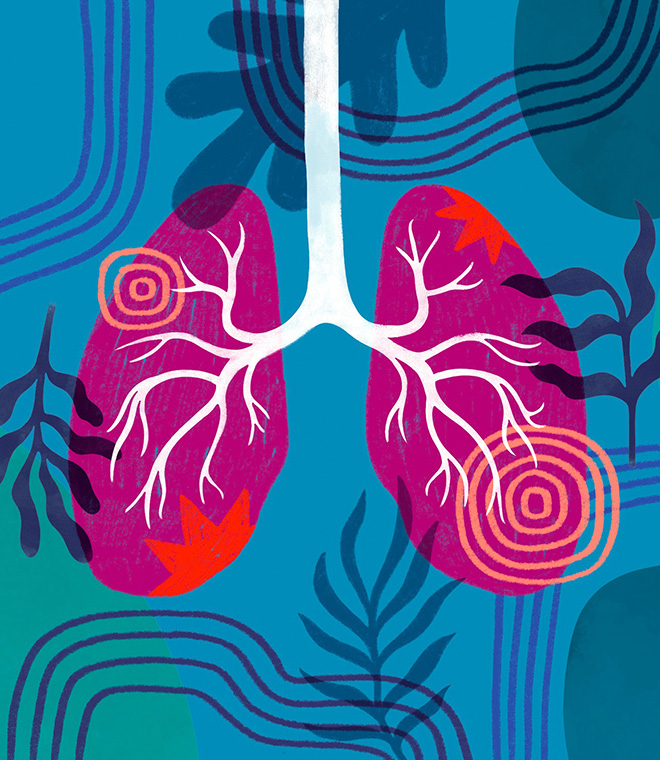Health
Symptoms and warning signs of an asthma attack
Sep 27, 2022 • 7 min
Having an asthma attack can be a frightening experience. Asthma attack symptoms can include shortness of breath, coughing, wheezing and chest tightness. But with the right treatment plan, you can stop or even avoid an asthma attack. Learn more details about asthma attacks.
What is asthma?
Asthma is a respiratory condition caused by inflammation and obstruction of the bronchial tubes (the tubes that let air in and out of your lungs). Asthma is a chronic disease that causes repeated episodes of wheezing, breathlessness, chest tightness and nighttime or early morning coughing. It requires long-term management.
What is an asthma attack?
Sometimes the lungs become irritated, which causes the muscles around the airways to tighten. This narrows the airways further and makes it harder to breathe. This is called an asthma attack or flare-up. Asthma attacks can be mild, moderate or severe and can be life-threatening.
Asthma treatment
There are several kinds of asthma medications. Many people take both a long-term control medication and a rescue medication. A long-term control medication is taken daily to keep your asthma at bay, while a quick-relief medication, also known as a rescue inhaler, is taken when you have an asthma attack.
Sometimes people need additional supplementation with biologics for long-term control. People with exercise-induced asthma are often told to use their rescue inhaler before starting to exercise so that they avoid having an attack. People with allergy-induced asthma may also be prescribed medications that focus on controlling the allergies through daily or seasonal medications or a series of desensitization shots.
Managing your asthma well can help reduce your chance of asthma attacks. Your healthcare provider will create a written, individualized treatment plan, called an “asthma action plan,” to help control your asthma.
Your plan will include details of the medications you should take, including how much of each and when, based on your current peak flow meter reading. A peak flow meter measures how well air moves out of your lungs. You'll figure out your personal best peak flow measurement when you feel well. Then, if you have an asthma attack, you can measure your peak flow and compare it to your personal best number to determine if you're having a mild or severe attack and medicate appropriately according to your action plan.
Note that asthma can change over time, so it's important to see your provider as often as directed. This way, your provider can tweak your treatment plan, if needed, to keep your symptoms under control and reduce your risk of future attacks.
What causes asthma attacks?
When you have asthma, many things can irritate the lungs and activate changes in the airways. Asthma attack triggers can include allergens, chemicals, odors, respiratory infections, physical activity, smoking, seasonal weather changes and emotions. Specific asthma triggers vary among people.
A trigger that aggravates one person's symptoms won't necessarily bother another person. Avoiding your triggers as much as possible is a key part of managing asthma. Asthma attacks are more likely to occur when your asthma isn't well controlled.
What does an asthma attack feel like?
Symptoms of an asthma attack can vary among people. Work with your healthcare provider to learn your early warning signs of an asthma attack. Asthma attack symptoms can include the following:
- Shortness of breath or trouble breathing
- Coughing
- Wheezing (a whistling sound when you breathe)
- Chest tightness
The length of an asthma attack can vary. The duration depends on what brought on the attack in the first place and how long your airways have been inflamed. Mild attacks may only last a few minutes, whereas more serious episodes can last hours or even days. Note that severe asthma attacks may subside more quickly with appropriate treatment.
Asthma attack treatment
To stop an asthma attack, you must recognize your symptoms early and start treatment promptly. It's important that you stay calm so you can follow your action plan. If you use the rescue inhaler more than two times a week, talk with your provider about changing or starting a daily medication.
Minor asthma attacks may stop when you follow your action plan. Severe asthma attacks may not respond to home treatments and may become life-threatening. Symptoms of a serious asthma attack can include severe wheezing, not being able to speak much due to shortness of breath, straining your chest muscles to breathe and low peak flow readings. If you have signs of a severe asthma attack that don't improve when you follow your action plan, such as using a rescue inhaler, seek medical help or call 911 right away.
Managing asthma involves keeping up with checkups, staying away from asthma attack triggers, recognizing the signs of an asthma attack and knowing what to do if your asthma worsens. If you have an asthma attack, following your action plan as directed by your provider is a must.
Clinically reviewed and updated March 2022.
Sources:
1. https://www.nhlbi.nih.gov/health-topics/asthma
4. https://www.uptodate.com/contents/management-of-acute-exacerbations-of-asthma-in-adults
5. https://acaai.org/asthma/symptoms/asthma-attack
6. https://www.aafa.org/page/asthma-symptoms.aspx
7. https://www.cdc.gov/asthma/faqs.htm
8. https://www.nhlbi.nih.gov/files/docs/guidelines/asthma_qrg.pdf
9. https://www.mayoclinic.org/diseases-conditions/asthma-attack/symptoms-causes/syc-20354268
10. https://www.aafa.org/asthma-treatment-action-plan/
11. https://www.aafa.org/asthma/asthma-diagnosis/lung-function-tests/peak-flow-meters.aspx



